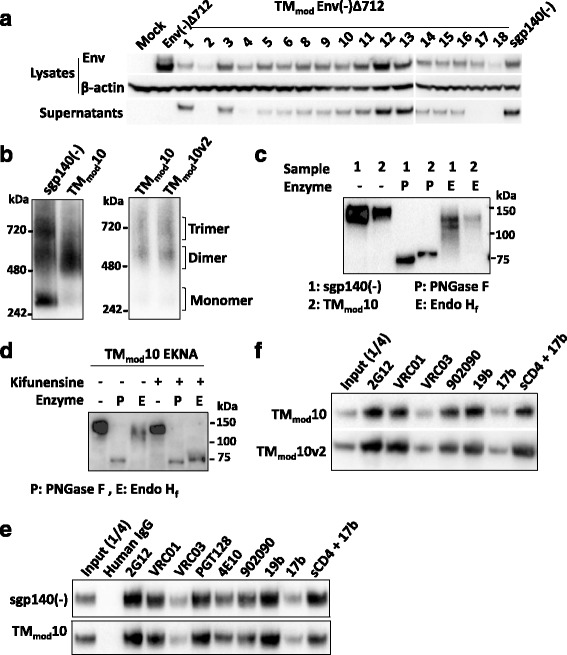Fig. 2.

Characterization of TMmod mutant Envs. a Cellular lysates and supernatants from 293T cells that were mock-transfected or transfected with TMmod Env DNAs were Western blotted. Western blots shown in this figure used goat anti-gp120 antibody or a mouse anti-β-actin control. The TMmod Envs with at least two new charged residues in the transmembrane region were secreted. The control TMmod18 Env was inefficiently expressed and not secreted. The sgp140(−) Env lacks the transmembrane region. b The secreted Envs were analyzed by Blue Native PAGE. The sgp140(−) glycoprotein migrated as a heterogeneous mixture of monomers, dimers and trimers. The representative TMmod10 protein migrated predominantly as a dimer. The TMmod10v2 glycoprotein was also largely dimeric. Note that HIV-1 Envs migrate more slowly than expected in Blue Native gels. c Transfected cell supernatants containing sgp140(−) and TMmod10 Envs were either mock-treated or treated with PNGase F (which removes all N-linked glycans) or Endo Hf (which removes only high-mannose glycans). The Western blot shows that both sgp140(−) and TMmod10 Envs resist Endo Hf treatment, which indicates that they contain mostly complex carbohydrates. d Transfected cells expressing the E168K + N188A (EKNA) variant of TMmod10, which allows HIV-1JR-FL Envs to be recognized by the PG9 and PG16 neutralizing antibodies [96–99], were incubated with 50 mM kifunensine (a mannosidase I inhibitor). Cell supernatants were collected, deglycosylated with PNGase F or Endo Hf, and Western blotted. Addition of kifunensine converted TMmod10 glycosylation from mostly complex glycans to high-mannose glycans. e, f Cell supernatants containing the indicated soluble glycoproteins were precipitated with the indicated antibodies, and the precipitates were Western blotted with goat anti-gp120 antibody. The three soluble Envs exhibit a similar pattern of antigenicity. One-fourth volume of the supernatant used for immunoprecipitation was analyzed in the input lane. Data are representative of those obtained in at least two independent experiments
